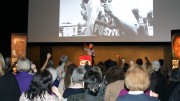Albert Mehrabian, a former professor at the University of California, Los Angels (UCLA), was a pioneer in the research of body language. Among other advances in the subject, he combined research from two books he wrote nearly 40 years ago to come up with one of the most famous rules of nonverbal communication: seven per cent of our communication is conveyed with words, 38 per cent with vocal tone and 55 per cent with facial expressions. This is an astonishing finding, and one that is often repeated in a variety of mainstream media. For example, recent books like The Graphic Designer’s Guide to Better Business Writing (2007), Dental Practice Health Check (2008) and Interpersonal Communication (2009) all mention the famous — or infamous — 93 per cent statistic.
To reach his result, Mehrabian used findings from two of his studies:
In the first study, participants were asked to rate the content of various words as positive, neutral or negative. The positive words were “dear,” “thanks” and “honey”; the neutral words were “oh,” “maybe” and “really”; the negative words were “terrible,” “brute” and “don’t.” The words were read to the study’s participants in either a positive, neutral or negative tone of voice.
In the second study, participants were asked to judge if the word “maybe” was positive, neutral, or negative, based on the face of someone in a photograph with positive, neutral, or negative facial expressions.
The results of his research suggested that the face and vocal tone convey 93 per cent of emotions and attitudes associated with the words in the studies, not 93 per cent of the meaning of the message. Unfortunately, this distinction is usually overlooked when an “expert” in body language wants to demonstrate the importance of their expertise, when, in fact, experts have suggested that the methodology Mehrabian used had a number of flaws.
Of the criticisms of the 93 per cent rule, some the most damning are that the laboratory conditions are unrepresentative of real life situations, the words in his first study are too arbitrarily classified as “positive,” “neutral” or “negative” and his percentages were a clustered amalgamation of the results of both of his studies.
Furthermore it has been suggested that the two studies simply cannot be put together because they compare two totally different circumstances. And yet, they have been combined to come up with the 93 per cent “rule.”
Psychologists Antonietta Trimboli and Michael Walker published a paper in the Journal of Nonverbal Behaviour in 1987, which gave another possible explanation of Merhabian’s results. They believed that the participants — who were just nice volunteers — inadvertently acted the way the experimenters had hoped — subconsciously wanting to please them. To test this hypothesis Trimboli and Walker developed an experiment to demonstrate that when the true intent of the experiment was concealed, the results indicated that the extent to which participants could discern the meaning of nonverbal communication was reduced dramatically.
In contrast to the 93 percent rule, a professor at the University of Texas, William Ickes, believes that we are most accurate at discerning what people are thinking by paying attention to their words, not their body language.
In an essay published in The Psychology of Superheroes, Ickes writes “Accuracy in this case depends heavily on understanding the particular words that other people use. [ . . . ] In effect, we learn to ‘read between the lines’ of what people actually tell us.” His research with colleague Randy Gesn, published in the Journal of Personality and Social Psychology in 1999, involved asking participants to try to discern what videotaped subjects were thinking and feeling by manipulating the visuals and audio of the tapes. Visual cues added very little to the participants’ accuracy for what they were thinking. However, the visual cues were slightly helpful in indicating what someone was feeling.
So how much of communication really is nonverbal? Because of the unconsciously semantic nature of body language, it is doubtful that there will ever be a quantifiable figure because it’s unlikely that an experiment could control for all of the variables affecting a result. To put this into perspective, consider this: If you see someone make a gesture (e.g., adjusting clothes, touching their hands), can you claim that you know why they did it? What if they don’t even know? Our gestures are the products of things like informally-learned cultural mannerisms, observations in our various environments and our biochemistry.
While there is no official certification for body language experts, some do exist — such as Dr. Paul Ekman, whose research was the foundation for the hit television show Lie to Me. But be careful when someone emphasizes the importance of nonverbal communication, because sometimes it’s not warranted. For example, in his book, What Every Body is Saying, Joe Navarro — a former nonverbal communication expert for the FBI — writes, “You might assume that as a career FBI agent who has at times been called a human lie detector, I can spot deceit with relative ease. [ . . . ] Nothing could be further from the truth! In reality, it is extremely difficult to detect deception.”
So, do actions speak louder than words? Well, if you want someone to understand what you’re thinking, then the research would suggest: no — just say it! (Ladies, I’m looking at you!) A more accurate rule for Merhabian’s research, contrasting with the first lines of this article, could be “93 per cent of human communication in these two incomparably isolated and methodologically flawed experiments is nonverbal,” but I understand that it doesn’t have as nice a ring to it.




